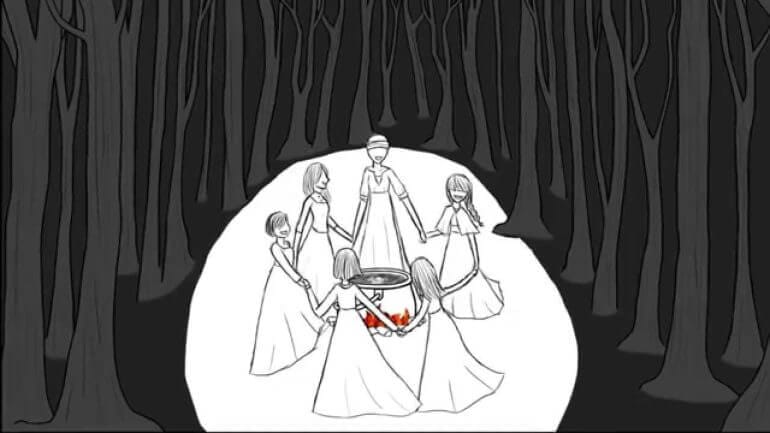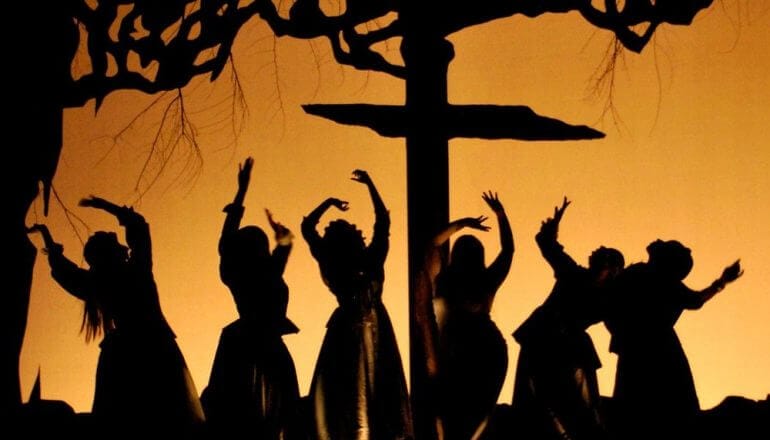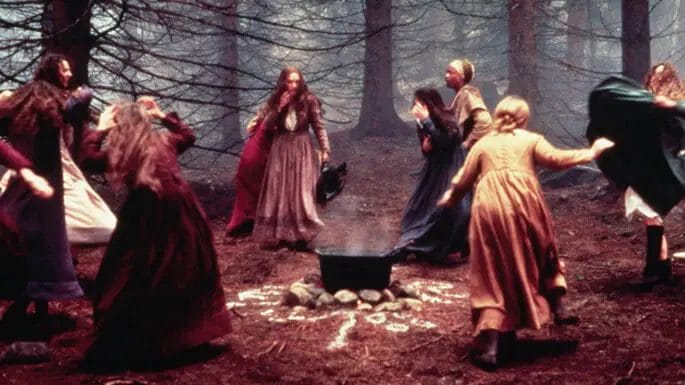The Crucible is a renowned play written by Arthur Miller that explores the hysteria and chaos of the Salem witch trials in the late 17th century. One of the pivotal moments in the play involves a group of young girls dancing in the woods, led by Abigail Williams. This forbidden act sets off a chain reaction of events, unleashing a wave of accusations and paranoia throughout the Puritan community. The dance in the woods serves as a catalyst, sparking the witch hunt that forms the heart of the play.

Mysterious Figures in the Woods
Have you ever ventured into the woods and felt like you were being watched? Or caught a glimpse of a shadowy figure darting behind the trees? The lure of the unknown has always fascinated human beings, and the presence of mysterious figures in the woods adds an element of intrigue and fear to our natural surroundings.

These mysterious figures can take many forms, from ghostly apparitions to strange creatures that defy explanation. They often appear in isolated and remote areas, where the veil between the human world and the supernatural seems thin. Whether they are the result of urban legends, folklore, or something more sinister, encounters with these figures have captivated the imaginations of people around the world.
The Legend of the Wendigo
One of the most well-known mysterious figures in the woods is the Wendigo. According to Native American folklore, the Wendigo is a malevolent spirit that possesses those who resort to cannibalism. It is said to be a tall, emaciated figure with icy blue eyes and a hunger that cannot be sated. Many claim to have seen the Wendigo lurking in the forests of North America, leaving behind a trail of fear and unease.
Stories of the Wendigo have been passed down through generations, serving as a warning against the darkest aspects of human nature. Some believe that encountering the Wendigo is a sign of impending doom or a punishment for past transgressions.
The Mothman Mystery
Another enigmatic figure that has captured the public’s interest is the Mothman. The Mothman is a winged creature described as being over six feet tall, with glowing red eyes and large wings. It gained notoriety in the 1960s when numerous sightings were reported in the small town of Point Pleasant, West Virginia.
Witnesses claimed to have seen the Mothman flying through the sky or perched on a bridge before tragic events occurred. The sightings were accompanied by feelings of dread and impending disaster. Some even believe that the Mothman is a harbinger of doom, appearing before major catastrophes.
Other Mysterious Figures
Of course, the Wendigo and Mothman are just two examples of the countless mysterious figures that haunt the woods. Every culture and region seems to have its own legends and tales of strange encounters. From the spooky Slender Man to the mischievous Pukwudgie, these figures ignite our imagination and keep us on edge.
So, why do these mysterious figures in the woods continue to captivate us? Perhaps it is the thrill of the unknown or the possibility that there are forces beyond our comprehension at work. Whatever the reason, the allure of the unknown remains strong, drawing us into the depths of the forest in search of answers.
In summary, mysterious figures in the woods have long been part of our folklore and urban legends. Whether they are supernatural entities or simply tricks of the imagination, encounters with these enigmatic figures spark fear and fascination. The legends of the Wendigo and Mothman, among others, continue to intrigue us and remind us that there are still mysteries lurking in the dark corners of the world.

Intriguing Dance Rituals in The Crucible
The Crucible, a play written by Arthur Miller, explores the dark and terrifying events surrounding the Salem witch trials of 1692. Throughout the play, various intriguing dance rituals play a significant role in unraveling the truth behind the accusations of witchcraft.
One of the most captivating dance rituals in The Crucible is the girls’ forbidden dance in the forest. In this scene, a group of young girls led by Abigail Williams, the play’s main antagonist, engage in a secretive gathering. As they dance and chant, their actions take on a supernatural aura, which sets the stage for the chaos that ensues in Salem. The dance serves as a catalyst for the girls to falsely accuse innocent townspeople of witchcraft, leading to a web of lies and hysteria.
Another intriguing dance ritual depicted in The Crucible is the court scene where Mary Warren, a former member of the girls’ group, attempts to expose the truth about their deceitful actions. In an act of desperation, she demonstrates the girls’ ability to mimic the symptoms of witchcraft through a carefully choreographed dance. This dance not only showcases the power of manipulation but also highlights the extent to which the townspeople are willing to believe in the supernatural.
Moreover, the climax of the play features a dramatic and mesmerizing scene known as the “hanging dance.” In an attempt to save themselves from being falsely accused, John Proctor and Rebecca Nurse, two prominent characters, refuse to falsely confess to witchcraft. As they face the gallows, they share a profound and haunting dance, symbolizing their defiance against the hysteria gripping the town. This poignant scene emphasizes the inner strength and resilience of the accused, ultimately questioning the validity of the trials and the blind faith of those involved.
These dance rituals in The Crucible not only serve as captivating moments in the play but also play a crucial role in advancing the plot and exploring the themes of deception, manipulation, and the power of collective hysteria. Through their execution, the dance rituals bring to light the complexities of human nature and the dangers of unchecked fear and paranoia.
In summary, The Crucible presents a captivating portrayal of dance rituals within the context of the Salem witch trials. These rituals not only add depth and intrigue to the plot but also serve as powerful tools for manipulation and deception. As the characters engage in these captivating dances, the audience is compelled to question the nature of truth, the power of belief, and the consequences of unchecked hysteria.

Hidden Identities Amongst the Trees
The world of trees is vast and diverse, with countless species spreading their roots across the globe. While most of us admire trees for their beauty and the multitude of benefits they provide, there is a hidden world within their midst. This hidden world consists of various organisms that have found refuge in the nooks and crannies of trees, adopting hidden identities to survive.
1. Epiphytes: The Masters of Camouflage
Epiphytes are plants that grow on the surface of other plants, particularly trees. They have evolved unique adaptations to live harmoniously with their host trees, extracting moisture and nutrients from the air and rain. These hidden identities allow them to blend seamlessly into their surroundings, making it difficult to spot them at first glance.
One example of an epiphyte is the orchid. Orchids often take residence on tree trunks, using their host as a sturdy foundation. Their vibrant and intricate flowers stand out, but their foliage is often disguised to blend in with the bark, making them elusive to the untrained eye.
2. Bark Beetles: Silent Tree Assassins
Bark beetles are tiny insects that have a significant impact on the health of trees. These seemingly harmless creatures burrow into the bark, creating intricate tunnels that disrupt the tree’s vascular system. While they may appear inconspicuous, they are responsible for the death of millions of trees worldwide.
These beetles often go undetected until it is too late. By the time visible signs of infestation appear, the tree’s health has already deteriorated significantly. This hidden identity allows them to silently carry out their destructive activities without drawing attention.
3. Tree Dwelling Animals: Masters of Disguise
Trees not only provide shelter but also serve as a hunting ground for various animal species. Many animals have developed unique adaptations that allow them to blend in seamlessly with their tree-dwelling habitat.
An excellent example of a tree-dwelling animal is the mossy leaf-tailed gecko. This remarkable creature has evolved to mimic the appearance of moss-covered branches. Its body shape, coloration, and texture closely resemble its surroundings, making it nearly indistinguishable from the tree itself. This hidden identity provides protection from predators and increases its chances of successfully ambushing prey.
4. Fungi: The Silent Network
Beneath the surface of the forest floor lies a hidden network of fungi known as mycelium. These thread-like structures intertwine and extend their reach to form a web that connects trees and other plants in a symbiotic relationship.
While fungi may not have the same visual appeal as other hidden identities amongst trees, their presence is vital for the overall health and survival of the forest ecosystem. They facilitate nutrient exchange, enhance the tree’s ability to absorb water, and even communicate with neighboring trees through chemical signals. This hidden identity plays a crucial role in maintaining the balance and interconnectedness of the forest.
Summary
The world of trees is not just about the majestic trunks and lush canopies. It is also a world filled with hidden identities that thrive amongst the trees. From epiphytes camouflaging themselves on tree branches to bark beetles silently wreaking havoc on the bark, each organism has its unique story to tell. The hidden identities amongst the trees serve as a reminder of the intricate and delicate balance of nature, where every organism plays a vital role in the grand tapestry of life.
4. The Enigmatic Dancers of The Crucible
The Crucible, a timeless classic by Arthur Miller, is a play that delves into the dark corners of human nature, exploring themes of mass hysteria, deception, and persecution. At the heart of the play lies a group of enigmatic characters known as the dancers, whose presence and actions play a vital role in the unfolding drama.
The dancers, a group of young girls from Salem, Massachusetts, are introduced as innocent and carefree individuals at the beginning of the play. However, as the story progresses, their actions and motivations become increasingly mysterious and perplexing. They become central figures in the town’s witchcraft hysteria, accusing innocent individuals of practicing witchcraft.
The true nature of the dancers and their intentions remain a subject of debate throughout the play. Some believe that the girls are genuinely possessed by the devil, while others argue that they are merely acting out of fear or personal vengeance. This ambiguity adds to the complexity of their characters and keeps the audience guessing about their true motives.
One of the most compelling aspects of the dancers is their ability to manipulate the events in Salem. Their presence alone instills fear and uncertainty in the townspeople, leading to widespread accusations and trials. Their power lies not only in their accusations but also in their ability to control the narrative and influence the actions of those around them.
Furthermore, the dancers’ enigmatic nature is enhanced by their group dynamics. Although they appear to be united in their pursuit of justice, there are subtle hints of rivalry and jealousy among them. This internal conflict adds another layer of complexity to their characters and raises questions about their true motivations.
The dancers’ actions also serve as a reflection of the larger themes in the play. Their accusations and manipulations highlight the destructive power of mass hysteria and the dangers of unchecked authority. Through their actions, Miller explores the consequences of fear and the lengths to which people will go to protect their own interests.
In conclusion, the enigmatic dancers of The Crucible are a pivotal element of the play’s narrative, adding intrigue and complexity to the story. Their motivations and true nature remain shrouded in mystery, keeping the audience captivated and engaged. Through their actions, Miller explores timeless themes of fear, deception, and the fragility of truth. The dancers serve as a reminder of the dangers of unchecked power and the destructive nature of mass hysteria.
Unveiling the Forest Secrets in The Crucible
The Crucible, a renowned play written by Arthur Miller, takes us back to the haunting days of the Salem Witch Trials in the late 1600s. While the plot revolves around the hysteria and paranoia that gripped the town during this infamous period, one element that adds a layer of mystery and intrigue is the forest.
In this section, we will delve into the role of the forest in The Crucible and its significance in unraveling the secrets that lie within.
The Forest as a Symbol of Freedom and Purity
Throughout The Crucible, the forest serves as a symbol of freedom and purity, contrasting the oppressive and corrupt society of Salem. It is in the forest where the characters find solace and escape the constraints of Puritan society.
For example, in Act I, Abigail Williams, the main antagonist, leads the young girls of Salem into the forest to practice forbidden rituals. The forest becomes a sanctuary where they can break free from the rigid rules and expectations imposed upon them. In this sense, the forest represents a realm of untamed desires and rebellion.
The Forest as a Haven for Witchcraft
As the play progresses, the forest takes on a darker and more sinister role. It becomes a haven for witchcraft and a place where the accused witches, like Tituba and Sarah Good, are rumored to gather and communicate with the devil.
The forest becomes a setting for clandestine meetings and rituals that further fuel the hysteria in Salem. It is here that the characters engage in forbidden practices and make pacts with the supernatural forces they believe will grant them power. The forest, with its dense foliage and hidden pathways, provides the perfect backdrop for these illicit activities.
The Forest as a Symbol of Fear and Danger
While the forest initially represents a sense of freedom, it eventually becomes a source of fear and danger for the characters. The town’s obsession with rooting out witches leads to accusations and trials, and the forest becomes associated with evil and darkness.
In Act III, the character of Mary Warren reveals that the girls were pretending to be under the influence of witchcraft in the forest. This revelation exposes the forest as a place where lies and deception breed, casting doubt on the legitimacy of the accusations made in Salem.
The Forest as a Catalyst for Truth and Redemption
Despite its ominous reputation, the forest also serves as a catalyst for truth and redemption in The Crucible. It is in the forest that John Proctor confronts Abigail, forcing her to admit that the accusations of witchcraft are false.
Proctor’s brave act in the forest serves as a turning point in the play, leading to the unraveling of the trials and the exposure of the girls’ deceit. The forest, in this context, becomes a place where the truth can no longer be concealed, and where justice can prevail.
In Summary
The forest in The Crucible plays a multifaceted role, symbolizing freedom, fear, and the pursuit of truth. It serves as a powerful backdrop for the unfolding drama of the Salem Witch Trials, revealing the complex nature of human desires, fears, and the consequences of unchecked hysteria.
Through its portrayal of the forest, Arthur Miller invites us to examine the hidden secrets that lie within ourselves and the lengths to which we are willing to go to protect our own interests. The forest becomes a metaphorical space where the characters confront their inner demons and ultimately find redemption or damnation.
In the play “The Crucible,” it is believed that a group of teenage girls led by Abigail Williams were dancing in the woods. The girls were caught by Reverend Parris and their actions sparked the witch hunt in Salem. This event plays a significant role in the unfolding of the story.Conclusion:
In conclusion, the mysterious figures dancing in the woods in “The Crucible” played a crucial role in the development of the storyline. These clandestine gatherings not only sparked fear and paranoia in the Salem community but also served as a catalyst for the infamous witch trials. The enigmatic nature of the dancers blurred the lines between reality and superstition, driving the town into a frenzy of accusations and hysteria. The haunting presence of these forest revelries served as a reminder of the dangers of unchecked fear and the potential for mass hysteria to consume a community.
Through the powerful portrayal of the dancers in the woods, Arthur Miller sheds light on the destructive consequences of ignorance and the dangers of scapegoating. The dancing figures became a symbol of the unseen forces at work, fueling the witch hunt and ultimately leading to the tragic events that unfolded in Salem. The presence of these figures highlighted the fragility of society and the ease with which fear and suspicion can lead to the persecution of innocent individuals. “The Crucible” serves as a cautionary tale that resonates with audiences, urging them to examine the consequences of blind conformity and the importance of questioning authority.